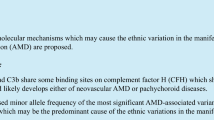Abstract
Purpose
The purpose of our study was to investigate the clinical and genetic characteristics of pseudodrusen subtypes and their incidence in advanced age-related macular degeneration (AMD).
Methods
We studied 84 eyes from 84 patients with pseudodrusen associated with advanced AMD, including typical AMD, polypoidal choroidal vasculopathy (PCV), retinal angiomatous proliferation (RAP), and geographic atrophy (GA). Multiple imaging modalities, including color fundus photography, spectral-domain optical coherence tomography (SD-OCT), near-infrared reflectance, and fundus autofluorescence, were employed to diagnose pseudodrusen and its subtypes. Subfoveal choroidal thickness was measured using SD-OCT. Subject eyes were classified into two subtypes, dot-dominant or ribbon-dominant, according to the maximum length of ribbon pseudodrusen. Genotyping was performed for ARMS2 A69S (rs10490924) and CFH I62V (rs800292) variants.
Results
The percentage of ribbon-dominant type pseudodrusen was significantly higher in eyes with RAP (69.6%) and GA (78.6%) compared with those with typical AMD (31.1%) (p = .0025 and .0017, respectively). Multivariate logistic regression analysis disclosed that incidence of female patients and coexisting large soft drusen was significantly higher in ribbon- than dot-dominant types (P = 0.014 and P = 0.008, respectively), while age, subfoveal choroidal thickness, and risk allele frequency for both ARMS2 A69S (rs10490924) and CFH I62V (rs800292) were not different between the two pseudodrusen subtypes.
Conclusions
Among eyes with advanced AMD associated with pseudodrusen, ribbon-dominant type pseudodrusen were more prevalent in eyes with GA or RAP and were associated with large soft drusen and female patients.




Similar content being viewed by others
References
Mimoun G, Soubrane G, Coscas G (1990) Macular drusen. J Fr Ophtalmol 13:511–530
Zweifel SA, Spaide RF, Curcio CA, Malek G, Imamura Y (2010) Reticular pseudodrusen are subretinal drusenoid deposits. Ophthalmology 117(303–312), e301. doi:10.1016/j.ophtha.2009.07.014
Klein R, Meuer SM, Knudtson MD, Iyengar SK, Klein BE (2008) The epidemiology of retinal reticular drusen. Am J Ophthalmol 145:317–326. doi:10.1016/j.ajo.2007.09.008
Zhou Q, Shaffer J, Ying GS (2016) Pseudodrusen in the fellow eye of patients with unilateral neovascular age-related macular degeneration: a meta-analysis. PLoS One 11, e0149030. doi:10.1371/journal.pone.0149030
Suzuki M, Sato T, Spaide RF (2014) Pseudodrusen subtypes as delineated by multimodal imaging of the fundus. Am J Ophthalmol 157:1005–1012. doi:10.1016/j.ajo.2014.01.025
Zhou Q, Daniel E, Maguire MG, Grunwald JE, Martin ER, Martin DF, Ying GS (2016) Pseudodrusen and incidence of late age-related macular degeneration in fellow eyes in the comparison of age-related macular degeneration treatments trials. Ophthalmology 123(7):1530–1540. doi:10.1016/j.ophtha.2016.02.043
Elfandi S, Ooto S, Ueda-Arakawa N, Takahashi A, Yoshikawa M, Nakanishi H, Tamura H, Oishi A, Yamashiro K, Yoshimura N (2016) Clinical and genetic characteristics of japanese patients with age-related macular degeneration and pseudodrusen. Ophthalmology 123:2205–2212. doi:10.1016/j.ophtha.2016.06.052
Sakurada Y, Yoneyama S, Sugiyama A, Tanabe N, Kikushima W, Mabuchi F, Kume A, Kubota T, Iijima H (2016) Prevalence and genetic characteristics of geographic atrophy among elderly japanese with age-related macular degeneration. PLoS One 11:e0149978. doi:10.1371/journal.pone.0149978
Finger RP, Chong E, McGuinness MB, Robman LD, Aung KZ, Giles G, Baird PN, Guymer RH (2016) Reticular pseudodrusen and their association with age-related macular degeneration: the melbourne collaborative cohort study. Ophthalmology 123:599–608. doi:10.1016/j.ophtha.2015.10.029
Joachim N, Mitchell P, Rochtchina E, Tan AG, Wang JJ (2014) Incidence and progression of reticular drusen in age-related macular degeneration: findings from an older Australian cohort. Ophthalmology 121:917–925. doi:10.1016/j.ophtha.2013.10.043
Cohen SY, Dubois L, Tadayoni R, Delahaye-Mazza C, Debibie C, Quentel G (2007) Prevalence of reticular pseudodrusen in age-related macular degeneration with newly diagnosed choroidal neovascularisation. Br J Ophthalmol 91:354–359. doi:10.1136/bjo.2006.101022
Ueda-Arakawa N, Ooto S, Nakata I, Yamashiro K, Tsujikawa A, Oishi A, Yoshimura N (2013) Prevalence and genomic association of reticular pseudodrusen in age-related macular degeneration. Am J Ophthalmol 155(260–269):e262. doi:10.1016/j.ajo.2012.08.011
Yoneyama S, Sakurada Y, Mabuchi F, Imasawa M, Sugiyama A, Kubota T, Iijima H (2014) Genetic and clinical factors associated with reticular pseudodrusen in exudative age-related macular degeneration. Graefe’s Arch Clin Exp Ophthal 252:1435–1441. doi:10.1007/s00417-014-2601-y
Kim JH, Chang YS, Kim JW, Lee TG, Kim CG (2015) Prevalence of subtypes of reticular pseudodrusen in newly diagnosed exudative age-related macular degeneration and polypoidal choroidal vasculopathy in Korean patients. Retina 35:2604–2612. doi:10.1097/IAE.0000000000000633
Author information
Authors and Affiliations
Corresponding author
Ethics declarations
Funding
This study was supported in part by JSPS (Japan Society for the promotion of Science) KAKENHI Grant Number 26861441.
Conflict of interest
All authors certify that they have no affiliations with or involvement in any organization or entity with any financial interest (such as honoraria, educational grants, participation in speakers’ bureaus, membership, employment, consultancies, stock ownership, or other equity interest, and expert testimony or patent-licensing arrangements), or non-financial interest (such as personal or professional relationships, affiliations, knowledge or beliefs) in the subject matter or materials discussed in this manuscript.
Ethical approval
All procedures performed in studies involving human participants were in accordance with the ethical standards of the institutional and/or national research committee and with the 1964 Helsinki Declaration and its later amendments or comparable ethical standards.
Rights and permissions
About this article
Cite this article
Shijo, T., Sakurada, Y., Yoneyama, S. et al. Prevalence and characteristics of pseudodrusen subtypes in advanced age-related macular degeneration. Graefes Arch Clin Exp Ophthalmol 255, 1125–1131 (2017). https://doi.org/10.1007/s00417-017-3622-0
Received:
Revised:
Accepted:
Published:
Issue Date:
DOI: https://doi.org/10.1007/s00417-017-3622-0




